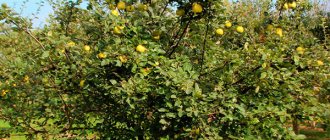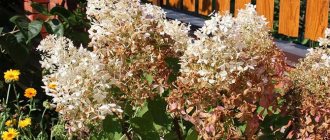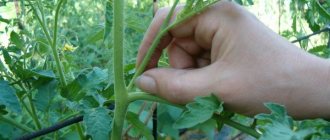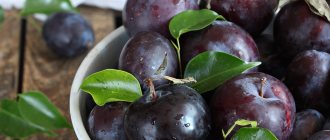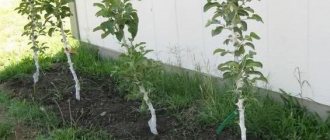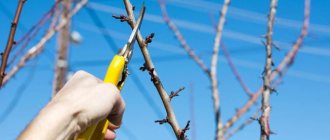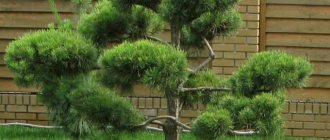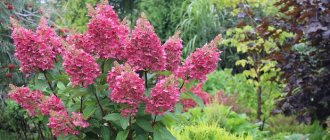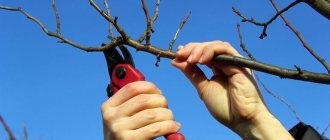Hazel is a wild shrub and usually forms undergrowth in coniferous-deciduous forests. Some of its species are cultivated by gardeners as nut-bearing plants and are valued for their high productivity for a long time (up to 150 years with proper care).
Since today nuts are a fairly expensive product, it is not surprising that many people try to grow them on their plots. At the same time, there are many who complain that the bush grows too much throughout the garden, like a real weed, and the fruits themselves grow small. These complaints are quite understandable: most likely, the hazelnuts were pruned incorrectly, which is why all its strength went into biomass. To prevent this from happening, you should know the basic rules for this procedure.
Do I need to trim hazelnuts?
What confuses everyone is the common point of view that wild plants do not need such careful care as breeding and ornamental varieties. After all, they grow and bear fruit in forests without any problems without any crown formation, plucking or cutting.
This is indeed partly applicable to some trees and shrubs. However, hazel is not one of them. In forestry, it is considered a weedy shrub, as it multiplies quickly and occupies all available areas, preventing the development and spread of other plants. All its strength goes into growth. That is why nuts collected in the wild are so small, and there are not many of them on one bush.
To prevent this from happening again in the garden, you need regular hazelnut pruning carried out according to all the rules. It promotes:
- effective development of hazel;
- early fruiting;
- high yield;
- full ripening of fruits;
- increasing the lifespan of the plant;
- increased winter hardiness;
- strengthening the immune system.
The main objective of the procedure is to form a sparse crown, free for sunlight and well ventilated. This stimulates the growth of short fruiting branches, i.e. it works to increase productivity. As a result, the nuts ripen large and there are quite a lot of them.
It is well known that hazel yields are unstable. One year it’s high, another year it’s low, or even zero. Annual pruning avoids such “swings”. Experienced gardeners who regularly conduct it do not complain about poor fruiting.
Hazelnuts in the photo:
Which option should I choose?
Formative
Constant annual formative pruning is the main process in plant care. In order for it to bear fruit abundantly, it is necessary to maintain constant light in the very center of the plant.
Advice
Hazel grows quickly, so you need to take care of thinning the bushes from the first year of planting.
Rejuvenating
With well-carried planting and proper agricultural technology, hazelnuts bear fruit up to ninety years, but at the age of twenty the branches of the trunk dry out and the yield decreases. In this case, it is necessary to do anti-aging pruning, which consists of cutting out old branches and creating all the conditions for rapid development for young ones.
Sanitary
Hazel branches gradually die off over the years. Therefore, it is necessary to carry out sanitary pruning and remove old and diseased branches.
Basic Rules
Let's consider what rules should be followed for pruning and shaping hazelnuts so that it gives only a positive effect.
How much to trim?
Branches that need to be removed are marked in advance. This will allow you to estimate the percentage of removed biomaterial from the total crown volume. It should not exceed more than 30%. Otherwise, the plant may get sick.
What to trim?
Extra shoots, diseased and damaged parts of the plant, dead wood. If you are in doubt whether it is better to remove one large branch or several small ones, the first option is preferable. This will reduce stress.
How to distinguish male inflorescences from female ones?
Already in the fall, you can see catkins on the hazel tree - these are male inflorescences that will produce pollen in the spring. The yield does not depend on their quantity. The main role is played by female flowers, which are hidden in the buds. Their pistils are reddish in color, they are so small and so well camouflaged that they can only be seen by looking closely at the shoots.
The problem is that in such conditions it is very difficult for them to catch pollen and begin to form a nut. This process is especially difficult when the crown is too thick. Therefore, it should be pruned to achieve good ventilation and pollination of female hazelnut flowers. They grow mainly on short side branches in the upper part of the bush (tree). Therefore, it is better not to touch them when cutting.
Attention! Tree trunk circle!
This is a forest shrub, so it will produce many shoots within the radius of the trunk circle. If you continue to grow it as a bush, you need to identify several main trunks and care only for them. All other growth must be pulled out, otherwise it will begin to draw useful nutrients from the soil that are needed for the formation of fruits. If you decide to make a tree out of hazel, the entire tree trunk circle is carefully weeded throughout the season - there should be only one trunk.
Walnut Tree Care
After pruning, walnut trees require mandatory care. It lies in the fact that plants must be regularly watered, fertilized, loosened the soil, destroyed weeds, mulched the tree trunk area, and carried out preventive measures against diseases and pests.
These procedures allow the shrubs to adapt faster due to crown pruning, and also to obtain a large harvest of nuts.
Fertilizers
You can increase the fruiting of hazel by adding the required amount of fertilizing.
Did you know? In Kievan Rus, hazel was considered a blessed tree that could never be struck by lightning.
Hazelnuts need to be fertilized by alternating organic and mineral products:
- in the fall, wood ash is added around the trunks;
- in April, add ammonium nitrate (15–20 g/1 m²);
- in early June, feed with a mixture of superphosphate (40–50 g), manure (3–4 kg), potassium sulfate (25–30 g), ammonium nitrate (40–50 g) per 1 m².
The fertilizer can not be diluted with water, but scattered dry around the bushes, loosened the soil, watered and covered with mulch.
Anti-parasite sprayers
Hazelnuts can be damaged by insects or various diseases. To protect plants from this harmful effect, it is necessary to take preventive measures.
Also read about how to deal with hazelnut diseases.
They are as follows:
- You constantly need to loosen the soil around the bushes, as there may be pest larvae there;
- remove fallen fruits and leaves, destroying them;
- feed the nut trees with fertilizers, and also treat them with special preparations that prevent the appearance of diseases and insects.
The most common parasites are the hazelnut beetle, walnut weevil, and alder leaf beetle. The most effective means against them include insecticides and acaricides, such as “Karbofos”, “Bazudin”, “Fozalon”, “Bi-58 Novy”, “Rogor”, etc. The drugs should be used only in accordance with the instructions supplied with them, using safety glasses, mask, special clothing.
Small rodents (mice, squirrels, hares) also cause considerable harm to hazelnut plants. You can protect hazelnuts from them by wrapping the trunks with fine mesh, plastic film, reeds, sedge, etc.
Learn how to germinate hazelnuts.
Growing hazelnuts in your summer cottage is not difficult. Even a novice gardener will be able to decorate his garden with this shrub, which brings not only aesthetic pleasure, but also produces a high yield of very tasty and healthy nuts.
What time of year
When is pruning most effective? Some say only in the fall. Others insist on a spring haircut. Still others do not rule out both options. Who is right?
in spring
Spring sanitary pruning of hazelnuts is mandatory in the following cases:
- after autumn planting;
- if there are specially broken branches left from the fall (see diagram below);
- formation of dead wood and breakdowns due to frosty and snowy winters;
- if neither sanitary nor formative haircuts were carried out in the fall.
The main rule of this season is to trim the hazel before flowering.
In summer
In the summer months, pruning should be exclusively forced, and is done if:
- the hazel is sick - infected branches infected with fungus are immediately removed;
- hazel moth, walnut weevils, longhorned beetles and moths, bud mites - the invasion of these pests causes drying out of branches, which also need to be cut off immediately;
- some shoots grow too rapidly and take all the energy from the tree, preventing the formation of nuts - it is recommended to carefully break them and leave them until autumn.
It is impossible to prune hazelnuts to form a crown in summer.
in autumn
- Deadlines
The main rule is to prune hazelnuts only after the leaf fall ends. In this case, you need to have time to carry out the procedure before frost, so as not to complicate the plant’s hibernation.
- Sanitary haircut
Unlike many other nut-bearing trees, pruning of hazelnuts in the autumn is carried out according to a special scheme. We focus on the fact that we are referring specifically to seasonal, sanitary pruning, the purpose of which is not to give the crown a certain shape, but to thin it out for good ventilation and a rich harvest for the next year.
Shoots that have grown too much over the summer are identified. 6-8 buds are counted from the trunk, and a break is made at a distance of 5 cm from the last one. In spring, the dried part in this place is carefully cut off. It is believed that this method stimulates the appearance of new side branches with female flowers and reduces stress for the plant. Some gardeners break off vigorously growing shoots throughout the season, and do the final pruning in October, before hibernation.
- After autumn planting
It is not necessary to prune young hazelnuts when planting in the fall, as this can be too traumatic for the seedling. There is a risk that it will not be able to survive the winter, since the root system has been seriously damaged. It is mandatory to thin the crown by a third the following spring.
- Other haircuts
In the fall, formative pruning is also carried out so that the bush or tree stays within the chosen model. After 8 years of plant life, gentle anti-aging pruning will also be required.
in winter
Some gardeners practice formative cutting of hazelnuts even in winter, when the plant is dormant and does not experience such stress as during active sap flow, when it is warm. However, there are also quite a lot of dangers on frosty days. For example, cutting a living branch instead of a dead one. Or, with a careless movement, break the shoots, which become incredibly fragile at low temperatures.
Pruning in the first 4-6 years
In the 4-5th year of life, the nut begins to bear fruit. By this time, it is necessary to complete the formation of the hazel and hazelnut crown. For hazel trees, a standard type of tree formation is chosen. This tree is easier to care for. The compactness of the crown allows you to place several plants in a small area. The peculiarity of pruning will be that the branches will receive enough light and air.
They begin pruning the hazel tree after the leaves have fallen. The conductors must be shortened by 50%. This is how a spherical shape is obtained, maintaining the height of the tree at 3 meters. Shoots growing from the side must be shortened, leaving 3 buds.
During the fruiting period, summer is used to remove powerful side shoots. They are simply broken, and when dry, removed. After such work, the buds will mature faster.
The hazelnut is left in the form of a bush if it is grown for a hedge or other decoration of the site. Leaving up to 12 shoots on the hazel, they form a lush shrub. But there will be fewer fruits on it, and their taste will be different from ordinary nuts.
Preparation
Consists of the following steps:
- If you are a beginner gardener, study the illustrated material, videos, preferably several (for comparison).
- Select a form and select the appropriate scheme for it.
- It is better for beginners to practice on some forest tree in order to get better at it and not ruin a valuable garden specimen.
- Prepare tools: ratchet pruner, lopper, hacksaw. Everything must be well sharpened.
- Choose a product to disinfect the wound that forms after pruning. This can be a special store-bought preparation or a home-made garden varnish.
- Stock up on fertilizer for additional feeding (another factor that reduces stress).
Why do you need autumn pruning of hazelnuts?
Caring for any tree or bush includes regular pruning. Hazelnut bushes, a garden form of hazel, which is pollinated by the wind, are also thinned. A good result will be if the crown is not thickened and the leaves do not interfere with the movement of pollen. Pruning hazelnuts in autumn helps:
- more efficient plant development;
- early entry into fruiting;
- better yield;
- good ripening of wood and fruits;
- increasing the lifespan of the plant;
- improving winter hardiness;
- resistance to fungal diseases and pests.
Pruning, which is carried out in the fall, regulates the timing of the spring growing season of hazelnuts, including the beginning of flowering and the development of branches. The goals that the gardener achieves:
- the formation of a sparse light crown, where sunlight and air flows freely enter;
- stimulating the growth of more short fruiting branches at the tops of all shoots.
Attention! The most productive are fairly mature branches of medium growth vigor
Trimming schemes
Under the bush
The simplest scheme. This is a natural form of growth for hazelnuts in the wild, and therefore the least traumatic. How it is produced:
- After planting, the seedling is trimmed to 15 cm.
- In the first 5 years, 6-7 shoots are left. Then their number can be increased to 15. Everything else is deleted in a timely manner.
- The shoots are formed in the form of a bowl (or boat), i.e. the middle of the bush should be free for good heating and lighting.
- Skeletal branches are broken every year in the fall and pruned in the spring.
- Leading tops are trimmed by ⅓.
However, keep in mind that collecting nuts from a bush is much more difficult than from a tree.
Under the tree
Pruning is more traumatic, but it makes collecting nuts easier and looks more decorative. Initially, you need to choose one of the traditional fruit forms - cupped, leader or tiered.
- The main trunk of the seedling is left. The rest of the growth is removed.
- Its growth is constantly monitored.
- From 7 to 12 skeletal branches are selected, the length of which is regularly shortened.
- Every year, the current season's growth, thickening and fatty shoots are cut by half.
Depending on the chosen shape of the bush, each hazel pruning scheme will be different. After 8 years of life, the plant needs rejuvenating procedures, when a new shoot is left in place of the old branch removed “under the ring”.
Step-by-step instructions on how to perform the procedure correctly
Formative
- For good fruiting, you need to maintain good sunlight in the center of the hazelnut.
- Also, during the procedure, you need to take into account that most of the female buds are located at the ends of the branches.
- The purpose of formative pruning is to maintain a certain number of branches in the crown of the bush, at which the light inside will remain good.
- To do this, excess branches and dense crown need to be cut out at the base, thereby ensuring thinning.
Under the vase
- To do this, every year you should cut out all the branches of the plant inside, and cut the central shoots at the level with the side shoots - to the outer bud.
- In too dense hazel thickets, you should cut out excess shoots only in the middle.
- Bend part of the side trunks to the side and secure in this position with wire.
- You will get something like a “vase” with a middle.
Under the tree
Pruning a tree-shaped plant goes like this::
- A standard is left on the seedling, the height of which is forty centimeters and seven strong branches of the first row.
- For the next six years, the main shoots are annually shortened by half of the bud directed outward.
- A tree is formed, the height of which is on average two and a half meters.
- Powerful side branches are cut off and only four buds are left.
- As a result, the finished tree consists of fifteen strong shoots and has a height of three meters.
- Hazelnut fruit branches with male and female flowers are not pruned.
Video about shaping hazelnuts into wood:
Under the bush
The bush form for the plant is natural, it is easy to form, you just need to slightly adjust the shoots:
- The bush needs to be trimmed to fifteen centimeters.
- The side branches and shoots will become skeletal branches on which the nuts will ripen.
- For any type of formation, the middle of the bush should remain free. With this pruning, the shoots are evenly warmed up and illuminated.
- For the harvest to appear, six or nine shoots are left in the first years, gradually increasing their number to fifteen.
- Skeleton-forming branches are pruned every year in the fall so that short shoots grow, which then form fruits.
- The tops are cut in half to stimulate active growth of branches.
Rejuvenating
The process occurs gradually:
- It is necessary to cut out two old trunks per year.
- In an eight-year-old bush, eight main shoots appear, while excess shoots are removed.
- In a bush older than ten years, ten or twelve shoots are formed.
- The bushes are cut closer to the ground, in the spring, and then covered with fertilizer and covered with film.
- As a result, young shoots are formed.
- Thus, by the twenty-five year cycle the plant will be completely rejuvenated, and the yield will not decrease.
Attention!
You can also carry out rejuvenation in a radical way: cut out the entire above-ground part at the base and next season form a crown from growing branches.
Video about anti-aging hazelnut pruning:
Sanitary
This type of pruning should be carried out regularly through autumn pruning to the ring:
- cut off the root shoots at the base;
- remove dry and weak branches, leave fruitful ones;
- shoots that are directed inside the crown are also removed.
Article on the topic
Difference between hazelnuts and hazelnuts.
After care
What to do:
- Do not allow the tree trunk circle to dry out: water abundantly and regularly.
- In spring and summer, immediately after pruning, loosen the tree trunk circle deeply enough (10 centimeters). In the fall - dig up.
- Apply fertilizer: in spring - with nitrogen, in autumn - without it.
- Make sure that the wounds left after pruning do not leak or rot.
- Mulch with sawdust, peat or dry grass.
- Weed the tree trunk to remove weeds and young shoots.
Hazelnuts are not a spoiled plant, as they were originally intended to grow freely in the forest. But, if you plan to grow it on your site, you can always achieve increased productivity. One of the mandatory items is pruning. This is a traumatic and stressful procedure. Therefore, choose a scheme, purchase a tool and put the “forest dweller” in order on your site.
Related article: Pruning an apple tree
Nuances of the formation of individual varieties
The pattern of crown formation depends on the variety of cherry plum. Trees are tree-like, bush-like, hybrid and columnar
Before you start pruning, it is important to study the features of work on each type of
Tree-like
Most of the crop grows on 7-9 year old shoots. Therefore, it is recommended to cut branches only inside the crown. In this case, dry, damaged and downward growing branches are cut down. Then you should shorten specimens with highly branched and weakly branched shoots. If the annual growth is less than 50 cm, then the cherry plum is not shortened.
Upon reaching the age of 25, rejuvenating pruning of the cherry plum is carried out. This procedure is carried out on old trees in lean years, since the cherry plum will recover for several years after it.
Bush-like
On bushy varieties, fruits appear on annual shoots. As a rule, these varieties do not require pruning for the first 3-4 years after planting the seedling. If you do not prune the plant, fruiting goes to the branches growing on the periphery. If the procedure has not been carried out for too long and the tree is completely overgrown, then the formation of the crown takes place in stages over 2-3 years. First, thin out the crown and remove dry and damaged branches. Then, next year, some of the shoots are shortened.
Hybrid
Hybrid varieties are characterized by the fact that they produce abundant growth per year. Approximately up to 1 m per fruiting season, so such varieties will have to be pruned most often, almost annually. Every spring the crown is thinned out, leaving a few skeletal branches. Deformed, weak branches with the fewest shoots are cut down. Thinning allows access to sunlight to those branches that constantly bear fruit.
If you do not thin out the crown, the yield gradually drops, the fruits become smaller and taste sour. As soon as the yield begins to decline and the fruit begins to taste sour, the branches are thinned. It is usually carried out on 2-3 year old wood. If the annual growth is not rapid, then at 5-6 years.
Columnar
The purpose of pruning branches on columnar varieties is to remove some of the shoots on the main conductor. This measure will help reduce the growth of annual growth of branches and improve the quality of cherry plum yield
It is important to properly cut off unnecessary branches. To carry out the procedure, use only well-sharpened pruning shears.
This rule applies to pruning on all types of trees. If you use a blunt sector, creases will remain on the cuts, and this can lead to the spread of diseases.
Pests and diseases of hazel
Pests and their control
Among the pests, hazel trees can be bothered by walnut weevils, leaf beetles and longhorned beetles, as well as aphids and bud mites.
The bud mite is a small insect up to 0.3 mm long that overwinters in the buds of plants and lays eggs in them in the spring. Such buds can be seen with the naked eye: they swell to the size of a large pea. While healthy buds begin to bloom, buds affected by the mite dry out and die.
Aphids are small sucking insects that feed on plant cell sap and transmit viral diseases. Aphids are difficult to see, and this is their danger. As a result of the vital activity of aphids, the leaves of the plant curl, the shoots and buds are deformed, their development slows down, and the fruits do not ripen.
The nut weevil is a brown beetle up to 1 cm long. The caterpillar of the beetle has a milky yellow body and a red-brown head. The female beetle lays eggs in the unripe fruits, and they feed on the nut pulp. With severe damage, you can lose up to 50% of the crop.
- Viburnum: growing in the garden, pruning, propagation
The hazelnut (hazelnut) longhorned beetle is a very dangerous pest, a black bug up to 15 mm long on yellow legs. It lays eggs under the bark of young shoots. The larvae gnaw through the core of the shoots, and they dry out, and the upper leaves on them turn yellow and curl.
The nut leaf beetle is a 6-7 mm long beetle with violet elytra, the most dangerous leaf-eating pest of hazel. The beetle larvae have a dark green body, difficult to distinguish against the background of the leaves on which their development takes place. This beetle damages not only hazel trees, but also alder and willow.
Diseases and their treatment
Hazel is more resistant to diseases than to pests, but can be affected by rust, branch rot and powdery mildew.
Powdery mildew is a disease well known to gardeners, the symptom of which is a whitish coating on leaves and shoots, which over time becomes dense and turns brown. The affected parts stop growing, darken and die. Inflorescences do not form ovaries, and the winter hardiness of plants is greatly reduced.
Rust - this fungal disease is manifested by the formation of dark red tubercles on the upper side of the leaves, and round or oval pustules on the lower side. The spots gradually turn into stripes, and the leaves of the plant turn yellow and fall off.
White rot parasitizes hazel in two variants: as mixed rot of branches and as peripheral rot, and in both cases the plant can be severely damaged, even to the point of death of the hazel.
Hazel processing
If you find insects on a hazel tree, spread a film under it and try to shake them off onto it. If the pest infestation of hazel is very strong, you will have to resort to treating the plant with insecticides, and sucking insects are destroyed with acaricides. The best drugs for pest control are Karbofos, Actellik, Chlorophos and other drugs with similar effects.
Against fungal diseases, if they have become effective, you will have to use fungicides - Bordeaux mixture, copper sulfate and more modern copper-based preparations. But the best protection for hazel trees from fungi is compliance with agricultural practices, as well as good and timely care.
How to prune correctly for beginners
It is enough for novice gardeners to know the simple rules of pruning so that the tree does not suffer as a result of this procedure, and the pruning itself fulfills its purpose.
- Do not start pruning before the leaves have fallen.
- The branches are very long and also fast growing - the first candidates for breakage from gusty winter winds and excessive snowfall. Such parts of the tree should be shortened by a third of their length.
- It is necessary to distinguish between formative, regulating, rejuvenating and sanitary pruning: formative and regulating pruning is carried out on young trees (a plum is considered such until it reaches 15 years old), rejuvenating pruning on old ones (after 15 years, respectively), and sanitary pruning does not depend on the age of the tree.
- When pruning, branches must be cut strictly to the length indicated for this type of pruning. If you cut at too great an angle, the wood may crack. It is best to cut slightly diagonally.
- The pruning itself is best done with pruning shears or other sharp garden tools with a straight blade. Do not use a garden saw or other tools with jagged or scalloped blade edges, as they will seriously injure the tree. The edges of such cuts do not heal for a long time, pathogenic microorganisms enter them, and gum formation is observed. Secateurs are not suitable only for old skeletal branches: they will have to be cut down.
- It is advisable to treat any cuts, even with the smallest diameter, preferably with garden varnish, but you can also use oil paint or special substances.
Mature plum
An old tree will need rejuvenating pruning. Its essence is to remove old skeletal branches. In the spring, young fresh shoots will appear at the cutting sites (hence the name pruning), which need to be thinned out, leaving no more than four of the strongest and most promising ones. Thinning at the sites where skeletal branches are cut is done in July-early August.
Experienced gardeners warn that pruning too many branches in one procedure can have a detrimental effect on the tree: the plum tree may not be able to withstand such severe stress and die. Therefore, it is necessary to spread this procedure over time over 2-3 years, cutting off several old branches each fall, and not all at once.
A properly pruned old plum tree will have a longer fruiting period.
young
A young plum is pruned at the same time that a tree seedling is planted. Next, regulatory and formative pruning is applied. The crown itself is formed over the course of 15 years, after which young shoots are not subject to pruning; this procedure is applied only to branches that are dried out and affected by diseases and pests.
Formative pruning is needed to obtain an optimal crown shape, which helps the tree to winter well and not break under the weight of fallen snow, promotes good ventilation and better lighting. Such conditions contribute to greater resistance to pathogenic factors and increased productivity. In addition, a good, unthickened crown is much more convenient for harvesting.
To form a young plum crown, it is necessary to leave 5-6 strong branches, the minimum distance between them is 20 cm. The angle of the skeletal branches in relation to the trunk should be about 50 degrees, this is a guarantee that the plum will be well ventilated and receive enough sunlight. The thickened crown causes the plum to freeze even in slight cold weather. If necessary, the top of the tree is also shortened.
Columnar
The columnar plum has a compact crown, and the fruits themselves are grown along the trunk, unlike other trees, where spreading branches with fruits grow. A columnar tree does not need side branches, so they must be trimmed every year.
The main thing is to ensure the safety of the central conductor, which is not affected by trimming at all. When its top freezes, the tree will “throw out” 2-3 additional shoots in this place in the spring. You need to leave one of them, the strongest and strongest.
How to fertilize and feed
Mulching with sawdust, pine needles, and fallen leaves is done every autumn, including in the first year. Also in the initial period, the light-loving seedling is artificially shaded. After 1 week, water again. It's better to do this in portions. A new bucket is poured after the water has been absorbed. This action will prevent rotting.
| Potassium sulfate 60 g | Fertilizers containing potassium and phosphorus |
| Double superphosphate 150 g | |
| Humus 10 l | |
| Manure 10 l |
A hole fed with manure and fertilizers nourishes the plant and promotes its growth for several years. You don’t have to fertilize for 4 years.
Growing nuts in a pot
If you want to grow hazelnuts from a nut, it is not difficult, but you will have to wait quite a long time. By purchasing ready-made seedlings that are about two years old, you can get a harvest in 3–4 years. And from a nut, a full-fledged plant that produces fruits will grow only 6-10 years after planting.
Important! Hazelnuts planted with seeds do not retain the varietal characteristics of the bush from which they were obtained.
This propagation method is used primarily to obtain new varieties of nuts. But if the characteristics of the resulting fruits are not important to you, and the fact that you will have to wait quite a long time for them, you can try growing hazelnuts from seeds. To do this, you need to choose nuts that are undamaged, large, beautiful, and of high quality. After all, these are the ones that can make good bushes that bring a stable harvest.
The seeds must germinate. To do this, they are placed in water or wet sand. Even better results can be achieved if you carry out preliminary stratification of nuts at low temperatures, which will significantly improve their germination and protect future young plants from the negative effects of the environment.
The sprouted seeds are planted in a pot to a depth of 6–7 cm. It is better to fill it with soil that is well suited for hazelnuts: light, moist, with a low acidity level. It is advisable to mix it with compost or humus in equal proportions so that the young plant receives as many nutrients as possible and develops better.
Hazelnuts can grow in a pot for up to two years. We must remember to maintain optimal soil moisture and provide good lighting. When the plant reaches 15 cm in height and its stem near the root becomes 3 mm thick, it can be transplanted into open ground.
When and where to plant shrubs
It would be right to plant hazel in the fall. This must be done 2-3 weeks before the onset of stable frosts. Before the beginning of December, the seedling will have time to develop a root system.
Planting rules
For good pollination, it is better to plant hazel in several bushes at once. The optimal gaps between them are 6 meters, so that there are no cramped conditions for development.
- plow or dig up the ground;
- make holes 1 m wide, high, and long;
- fill them ½ full with humus or manure;
- pour 10 liters of water into each well;
- cover the seedling with soil so that the root rod protrudes 3 cm from it;
- water - 20 liters per hazel tree.
Selection of planting material
Planting material can be purchased in a store, at a fair, or prepared independently by a gardener. There are some rules, tips and recommendations on how to prepare for landing:
- Seeds. Sprout on the windowsill in small containers. They are kept for several months in a cold, dark place - in a refrigerator or cellar. Recesses in the ground are made 5 cm.
- Root shoots. Taken from a three-year-old plant, from the edge of the main bush. Before transplanting to a permanent location, you need to grow the shoots in the garden or in greenhouse conditions for 1-2 years. With this method, absolutely all varietal properties of the plant are preserved.
- Division. Branches with a root system up to 15 cm are separated from an adult bush. The method is suitable for defusing the hazel tree.
- Young cuttings. They take a two-year-old tree, the period when the sprouts begin to lignify. Planted in a mixture of peat and sand in a 1:1 ratio. Water along with the foliage.
- Saplings. To grow hazelnuts, you need a seedling without leaves, with a well-formed root 45-50 cm long. At the root there are 2 pairs of shoots 1.5 cm in diameter, 1-2 cm in size. Hazel trees are sown in rows or individual bushes.
How to form the crown of a fruit tree
There are several ways to care for the crown of a tree. You need to look at them to understand the main features. Then it will be possible to understand what exactly needs to be used in a particular case.
Tier rarefaction
This is a fairly popular method. It allows you to preserve the natural appearance of the tree. This is how pruning should be done:
All growth 40 cm high must be cut off. Pairs of shoots up to 20 cm long are selected, which look in more than one direction. They must be left, and everything nearby must be cut off. The following season, the procedure is repeated, leaving two more branches 50 mm above the first pair. In this case, they need to be cut by 10 cm. Rejecting competing branches
It is important to ensure that the branches are located 10 cm below the main branch.
All pagons that are not included in the frame must be cut off.
While working, you must use garden shears.
Vertical palmette
This method is a little more complex, so it is worth considering in the form of step-by-step instructions.
This is what this method of crown formation looks like
Table 1. Step-by-step instructions for forming a tree crown
| Step, no. | Description | Photo |
| 1 | Planting an annual seedling without branches. | |
| 2 | Tightening the plant with several slats after planting. Usually six pieces are used, after which they are tied with rope or twine. | |
| 3 | The trunk is cut so that its height does not exceed 0.6 meters. In this case, it should have up to three buds. | |
| 4 | The upper bud should be directed towards growth. For this, slats are used. | |
| 5 | In autumn, all shoots located on the upper tiers are pruned to the third bud. | |
| 6 | The next year a new tier of the tree is formed. |
Spindle pruning
In this case, the crown of the tree resembles a cone. It looks aesthetically pleasing, but it is necessary to use an additional rail so that the crown has the appropriate shape.
Here's how to do everything in this case:
- for an annual tree, you need to select the four strongest and healthiest branches, which are located on the upper tiers (in this case, the maximum height from the ground should not exceed 55 cm);
- these branches need to be reduced by ½;
- the main trunk must be cut off so that there are no more than three buds on top;
- in the fall, all branches need to be pulled back and tied up so that they form the appearance of a Christmas tree;
- after a year, the trunk needs to be reduced by 1/13 of the new growth, and the twine or other rope that was used for garter is made smaller by 1/14.
Thus, by constantly repeating this principle, you can get a beautiful crown and a rich harvest.
Formation of a cup-shaped crown
Using this method, it is possible to form a beautiful crown. It is used, as a rule, for weak crops, which are considered quite whimsical. It is necessary to install a special standard at a height of 50 cm, and you also need to leave approximately 30 cm for the skeletal branches. All other shoots need to be shortened.
Here's how to form this type of crown

